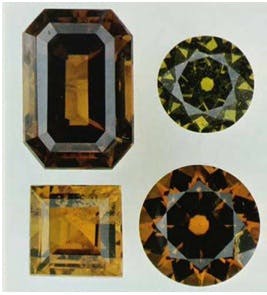Idocrase Value, Price, and Jewelry Information
Idocrase is one of the lesser known and more beautiful collector gems. When properly cut it is as bright and attractive as the grossular garnets, which it so strongly resembles. The complexities of its chemistry lead to a huge range in properties and colors. Cuttable material is known from Italy (brown and green), Quebec (pale green, bright yellow), New York (brown), Pakistan (green), Kenya (brown and green).
1 Minute Read
Idocrase is one of the lesser known and more beautiful collector gems. When properly cut it is as bright and attractive as the grossular garnets, which it so strongly resembles. The complexities of its chemistry lead to a huge range in properties and colors. Cuttable material is known from Italy (brown and green), Quebec (pale green, bright yellow), New York (brown), Pakistan (green), Kenya (brown and green).
Start an IGS Membership today
for full access to our price guide (updated monthly).Idocrase (Vesuvianite) Value
Optics: Variable depending on paragenesis and mineral associations.
Uniaxial (+) or ( - ); sometimes anomalously biaxial (-) or (+); twinned.
Incredible array of elements substitute in the idocrase structure.
Identifying Characteristics
Chart
Occurrence: Serpentines and related rocks; contact metamorphic deposits, especially in limestones and dolomites: alkalic rocks; regionally metamorphosed rocks.
Finland, Japan; Korea; Tanzania.
Arkansas.
California: californite; also crystals at Pulga.
Ala, Piedmont, Italy: fine brown and green crystals.
Zillerthal, Tyrol, Switzerland: brown crystals; also at Zermatt, other locations.
Laurel, Quebec, Canada: bright yellow grains and masses. Amity, New York (xanthite): brown crystals, large; seldom cut.
Telemark, Norway(cyprine): fine blue masses with pink thulite.
Asbestos, Quebec, Canada: superb crystal groups and masses, apple green, sometimes colored deep green by Cr or pink by Mn.
Kenya: green and brown crystal fragments suitable for faceting.
Sanford, Maine: brown and green crystals and masses.
Wilui River, USSR: green crystals (known as wiluite).
Morelos, Mexico: green crystals associated with pink grossular in lake bed.
Quetta, Pakistan: fine green crystals; some transparent.
Comments:Idocrase is one of the lesser known and more beautiful collector gems. When properly cut it is as bright and attractive as the grossular garnets, which it so strongly resembles. The complexities of its chemistry lead to a huge range in properties and colors. Cuttable material is known from Italy (brown and green), Quebec (pale green, bright yellow), New York (brown), Pakistan (green), Kenya (brown and green).
Californite is a massive idocrase-grossular mixture reported first from California and later found in various other localities, such as Africa and Pakistan. The density is 3.25-3.32 and there is a strong 4610 band in its spectrum, which is easily distinguished from the chrome spectrum of jadeite.
Name: From the Greek words idos and krasis, meaning mixed appearance, because idocrase crystal forms resemble those seen on other species. Vesuvianite from Mt. Vesuvius, where the mineral occurs in small, perfect crystals.
International Gem Society
Related Articles
Black Diamond Value, Price, and Jewelry Information
Chameleon Diamond Value, Price, and Jewelry Information
Gray Diamond Value, Price, and Jewelry Information
Green Diamond Value, Price, and Jewelry Information
Latest Articles
800 Years of Mogok: A Celebration in Tenuous Times
What is the Average Gemstone Faceting Yield?
Pyroxmangite Value, Price, and Jewelry Information
How to Identify Emerald Simulants and Synthetics
Never Stop Learning
When you join the IGS community, you get trusted diamond & gemstone information when you need it.
Get Gemology Insights
Get started with the International Gem Society’s free guide to gemstone identification. Join our weekly newsletter & get a free copy of the Gem ID Checklist!
